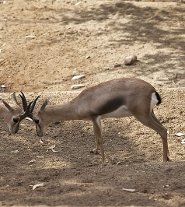 The Speke's Gazelle (Gazella spekei) is among the smallest of the Gazelles, reaching a length of 90.5 to 100.5 cm, equal to just over 3 feet, a height of about 50-60 cm, equal to 1.6 to 2 feet, and they weigh in at about 15 to 25 kg, or 33 to 55 pounds. The upper body is a brownish tan color, which is separated from the white belly by a black stripe. The unique folds on its nostrils inflate when excited, and are responsible for the loud resonant calls the Speke's Gazelle makes when threatened. Another unique behavior to the Speke's Gazelle is the blend of jumping, bouncing, and running they do when frightened.
The Speke's Gazelle (Gazella spekei) is among the smallest of the Gazelles, reaching a length of 90.5 to 100.5 cm, equal to just over 3 feet, a height of about 50-60 cm, equal to 1.6 to 2 feet, and they weigh in at about 15 to 25 kg, or 33 to 55 pounds. The upper body is a brownish tan color, which is separated from the white belly by a black stripe. The unique folds on its nostrils inflate when excited, and are responsible for the loud resonant calls the Speke's Gazelle makes when threatened. Another unique behavior to the Speke's Gazelle is the blend of jumping, bouncing, and running they do when frightened.The Speke's Gazelle has become endangered mainly because their grazing areas are often taken over by domestic livestock, and the range it covers has no protected areas so the threat of extinction will continue. The black stripes around the eyes reduce glare, and are bordered by white stripes, thus giving the animal a painted face appearance. Speke's Gazelles are found only on the horn of Africa, primarily in Somalia and some in neighboring Ethiopia. Like most animals living in a hot and dry scrubland environment, it is mostly active in the early morning and late evening hours, feeding on leaves, herbs and grass while resting during the day.
Both male and female Speke's Gazelles have horns, males have longer curved horns while females have smaller straight horns. The Speke's Gazelle is on the menu of several predators including the Leopard, Hyena, Lion, Python, and Cheetah, thus the young lie hidden and motionless in the brush until they are weaned at about three months. After a pregnancy of about 7 months, a single young is born among herds of about 12 to 20 animals, and Speke's Gazelles usually live about 12 years. Herds are composed of either a dominant male with his breeding harem covering an area of half to 2 square miles, or the bachelor herd of young and juvenile males.
Picture of the Speke's gazelle by Sanjay Acharya, licensed under the Creative Commons Attribution-Share Alike 3.0 Unported license.
Keywords: horn
The Speke's gazelle is listed as Vulnerable (VU), considered to be facing a high risk of extinction in the wild, on the IUCN Red List of Threatened Species
Namings for the Speke
A young / baby of a Speke is called a 'calf'.Some facts about the
Speke's gazelle
Adult weight : 20 kg (44 lbs)
Female maturity :511 days
Gestation : 197 days
Litter size : 1
Interval between litters : 205 days
Weight at birth : 1.253 kg (2.7566 lbs)

Custom Search